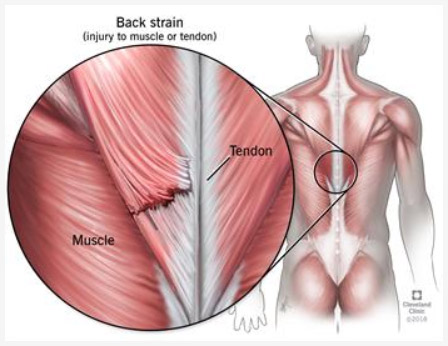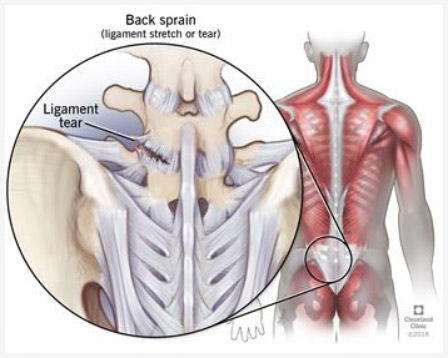Below are just a few of the most common terms you may hear in discussions about back injuries and treatments


Image source: https://my.clevelandclinic.org/health/diseases/10265-back-strains-and-sprains
- Discs: The fluid-filled pouch that sits between each of the 24 moving vertebrae.
- Herniated Disc: a condition where the soft, gel-like center of a spinal disc protrudes or leaks through its tough outer layer, potentially pressing on nearby nerves and causing pain or discomfort.
- Fascia: A connective tissue that encases muscles and other soft tissues, providing support and structure while allowing flexibility and movement.
- Ligaments: The dense, somewhat elastic tissue that connect bones. Ligaments surround the spine and hold it in place while allowing us to bend and twist. Ligaments have have the ability to stretch (within limits) and then return to their normal position.
- Muscles: Running the length of the spinal cord, muscles support the spine and give our back the strength it needs to push, pull and lift objects.
- Tendons: Similar to ligaments but connect muscles to bones rather than bones to bones, enabling the affected body part to move.
- Sacrum: a large, triangular bone at the base of the spine and connected to the pelvis. The sacrum strengthens and stabilizes the pelvis.
- Spinal Cord: long strand of fragile nerve tissue that extends from the base of the brain stem to nearly the bottom of the spine. The spinal cord allows the brain to communicate with the rest of the body.
- Strain: A very common injury that results from pulling, twisting, tearing, stretching or overworking a muscle or tendon. Often a result of lifting or pulling something incorrectly or long term, repetitive motions.
- Sprain: A very common injury that results from tearing or over stretching a ligament. Often a result of a twist, fall or strike to the body.
- Subluxation: A very important concept in chiropractic care, subluxation refers to the slight misalignment of vertebrae.
- Vertebrae: The individual bones that form the spinal column. They protect the spinal cord and provide structural support to the body.
If you have back-related pain, injuries or concerns — or you know someone who does — Dr. Jeffrey Meyers D.C. in Omaha is a member in good standing of the American Chiropractic Association. In practice since 1996, and has the qualifications and experience to offer natural, safe, and long term solutions to back pain issues or many other health concerns. To schedule an appointment, contact Back2Health chiropractic clinic in Omaha today.


